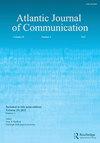Media exposure and intentions to wear face masks in the early stages of the COVID-19 outbreak: the mediating role of negative emotions and risk perception
IF 1
Q3 COMMUNICATION
引用次数: 14
Abstract
ABSTRACT Guided by the Appraisal Tendency Framework (ATF) and the Protection Motivation Theory (PMT), this study investigated the relationships between exposure to COVID-19 information conveyed through mainstream media and social media, negative emotions, risk perception, and intentions to wear face masks. An online survey was conducted with 590 Americans during the early stages of the COVID-19 pandemic (April 2020). Results indicated that while mainstream media were associated with fear, anxiety, and anger, social media were not. In turn, fear and anxiety were positively associated with risk perception, which increased intentions to wear face masks. Anger was negatively associated with risk perception, which reduced intentions to wear face masks. Mediation analyses revealed that these negative emotions and risk perception mediated the association between mainstream media exposure and intentions to wear face masks. Results provided support for the utility of integrating of the ATF and PMT to predict mask wearing behavior in the early stages of the COVID-19 outbreak. Theoretical and practical implications were discussed.COVID-19疫情早期媒体曝光和戴口罩意愿:负面情绪和风险认知的中介作用
本研究以评估倾向框架(ATF)和保护动机理论(PMT)为指导,研究了通过主流媒体和社交媒体传播的COVID-19信息暴露与负面情绪、风险感知和戴口罩意愿之间的关系。在新冠肺炎大流行初期(2020年4月),对590名美国人进行了在线调查。结果表明,虽然主流媒体与恐惧、焦虑和愤怒有关,但社交媒体与之无关。反过来,恐惧和焦虑与风险感知呈正相关,这增加了戴口罩的意愿。愤怒与风险感知呈负相关,这降低了人们戴口罩的意愿。中介分析显示,这些负面情绪和风险感知在主流媒体曝光与戴口罩意愿之间起中介作用。研究结果为整合ATF和PMT来预测COVID-19暴发早期的口罩佩戴行为提供了支持。讨论了理论和实践意义。
本文章由计算机程序翻译,如有差异,请以英文原文为准。
求助全文
约1分钟内获得全文
求助全文

 求助内容:
求助内容: 应助结果提醒方式:
应助结果提醒方式:


